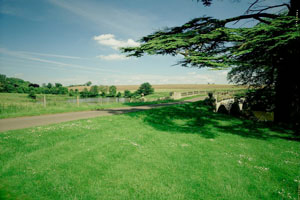Countdown to Capability Brown’s 300th birthday begins with funding boost
 An influential group of organisations, landowners and individuals are one step closer to marking the 300th anniversary of the birth of Lancelot Capability Brown (1716-1783) with a nationwide festival celebrating his life and influence in 2016 thanks to support from the Heritage Lottery Fund (HFL).
An influential group of organisations, landowners and individuals are one step closer to marking the 300th anniversary of the birth of Lancelot Capability Brown (1716-1783) with a nationwide festival celebrating his life and influence in 2016 thanks to support from the Heritage Lottery Fund (HFL).
The Capability Brown 300 Celebration and Festival has successfully passed through the first round in their bid and will receive £139,200 development funding from the HFL.
The bid is led by the Landscape Institute on behalf of a partnership which includes the Association of Gardens Trusts, NADFAS, English Heritage, the Garden History Society, the Historic Houses Association, the National Gardens Scheme, Natural England, Parks & Gardens UK, Visit Britain, Visit England, Kolab and the National Trust. They plan to bring the beauty and importance of Brown’s landscapes to a wider audience and celebrate the legacy of one of history’s most influential landscape architects with the Capability Brown 300 Celebration and Festival.
Gilly Drummond, Chair of the Capability Brown 300 Steering Group, commented: “Thanks to the Heritage Lottery Fund and a marvellous partnership we can now give Capability Brown, England’s greatest landscape artist his due recognition and spread the understanding and enjoyment of his genius for sustainable landscape design to a much wider audience, both nationally and internationally. We will move at speed to ensure that Capability Brown’s Birthday Celebrations and Festival 2016 will delight and inform as many people as possible all over the country. With the help of owners and managers and the support of volunteers, we hope to be able to have a huge number of Brown’s parks and gardens open to the public in 2016.”
Paul Lincoln, Director of Policy & Communications for the Landscape Institute points out that this is the first ever celebration of Brown’s extensive works and will bring together a huge range of events, openings and exhibitions: “Detailed information and a full listing of his sites will help build knownedge about Brown and fix him at the forefront of modern thinking on design and management of the natural environment,” he said. “The Festival will bring together a huge group of volunteers and provide opportunities for people of all ages and backgrounds to increase their knowledge and understanding of the way in which Brown’s legacy remains relevant to how we plan, manage and design our landscapes.”
Drew Bennellick, HLF’s Head of Landscape and Natural Heritage expressed her delight that they were able to give initial support towards the project: “As a landscape architect I have always appreciated the thrill Capability Brown must have experienced as he surveyed the land and considered how to transform the English landscape with his designs; moving hills, creating vast lakes and managing distant views.”
Known as the ‘father of landscape architecture’, Brown’s surviving landscapes, include the World Heritage Site at Blenheim Palace, Highclere Castle (the location of the ITV series Downton Abbey) Alnwick, Chatsworth, Compton Verney (pictured above) and Syon Park (pictured right).
He changed the face of the nation, creating a landscape style which forms the backdrop for most people’s picture of the quintessential English countryside.
Born in 1716 at Kirkharle, Northumberland, he was the fifth of the six children of William Brown, a yeoman farmer. He began work as a gardener at Kirkharle leaving in 1739. By 1741 he was working at Stowe and it was from here that he also began working as an independent designer and contractor.
His unmistakable style is derived from the two practical principles of comfort and elegance so his work always ensured that the landscape should provide for every need of a great house while at the same time had to cohere and look elegant.
For further information and updates log onto: www.capabilitybrown.org
Picture captions: Compton Verney ©English Heritage, John Critchely – Syon Park, Dukes River, ©Steffie Sheilds

